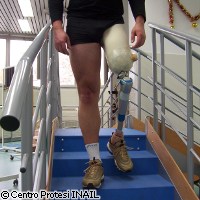EU project saves time and money with CUSTOM-FIT products
Global competition for the creation and manufacture of products is strong and calls for innovative action. Europeans are showing their prowess in this area by progressing from resource-based manufacturing to knowledge-based manufacturing, as well as from mass produced, single-use goods to new added value, custom-made and sustainable products. The EU-funded project CUSTOM-FIT is supporting this endeavour by developing and integrating a new and innovative manufacturing process based on Rapid Manufacturing (RM). The project is funded under the Sixth Framework Programme to the tune of EUR 9.25 million. The production technologies currently available on the market do not have the capacity to automatically manufacture unique, customised products. This is where CUSTOM-FIT enters the picture. According to the project partners, CUSTOM-FIT used knowledge-based Rapid Manufacturing (RM) techniques, Information Society Technologies (IST) and material science to successfully develop an innovative, yet cost-effective way to assemble medical and consumer products (e.g. prosthetic devices for patients without limbs) that are tailor-made for individuals and have unlimited geometrical freedom. From a social perspective, the project's results will benefit people who seek to improve their well-being and will optimise the products they use. The researchers underline that performance and comfort will be improved, and the number of injuries will be reduced. In particular, the 33-member consortium (35% of which are small and medium-sized enterprises), used 3-dimensional (3D) scans to obtain geometrical characteristics. The data were then used to adapt product shape with specialised Computer Aided Design (CAD), and RM technologies created the final result. The researchers took specific measurements of a limb stump and used specialised 3D CAD to produce a first socket design. Based on the design, a first male cast is used to thermoform the first socket (i.e. check socket), which the patient then tests. The check socket, according to the team, is produced via the Stereo Lithography Apparatus (SLA) additive technique. The process of heating a plastic sheet and then vacuuming it on top of a model or master creates thermoform diagrams. Thanks to this process, the researchers were able to steer clear of using costly moulds, which is the case in conventional methods. Ultimately, time was saved and the delivery time of the socket (i.e. delivery time was measured by calculating the patient's admission and discharge to and from the hospital) was reduced. Transfemoral amputee patients typically complete their rehabilitation programme in 25 days. CUSTOM-FIT's innovative technology could cut their hospital stay by 7 days and help them save EUR 2,000. The feedback provided by the patient will determine whether the socket is or isn't adjusted, and then a second male cast is made so as to produce the definitive socket which is composed of an inner soft thermoformable layer and an outer composite structure. A specific probe scanner scans the modified shape after the check socket is tested. The inner surface, from which the definitive socket is designed, is produced from the probe scanner. The innovative RM technique, what the partners called Plastic Powder Printing (PPP), then generates the definitive socket. The researchers said they used prosthesis production to test the manufacturing concept, in particular the transfemoral prosthesis socket - the interface between the residual limb and artificial leg. The residual limb is contained and protected, and forces from the limb are transferred to the prosthesis regardless of the patient's actions including running and standing. Comfort, durability and wearability are key, the team said. The project partners said CUSTOM-FIT targets a more holistic approach to the creation of products and services based on IST. They added that the project, scheduled to end this month, will achieve three main technical breakthroughs: automated design system for knowledge-based design of CUSTOM-FIT products; processing of graded structures of different material compositions; and RM for instant and on-demand manufacturing of graded CUSTOM-FIT products. The UK group Delcam is coordinating the project, and partners include the Czech Technical University in Prague (Czech Republic), the University of Patras (Greece), Inail Centro Protesi (Italy) and Wroclaw University of Technology (Poland).



